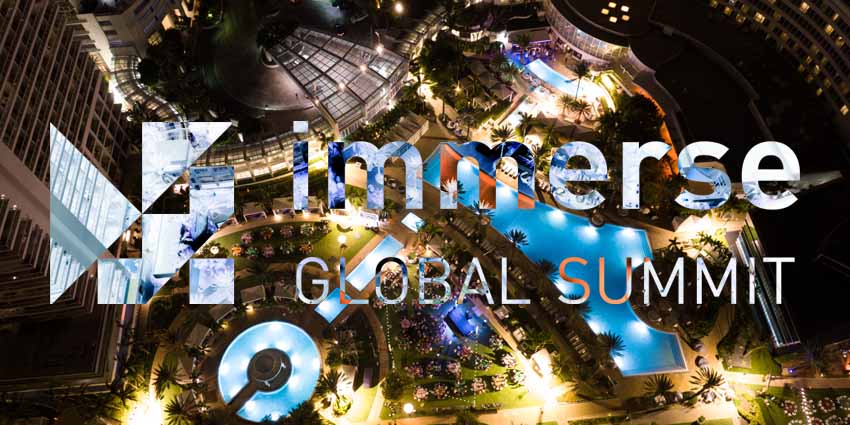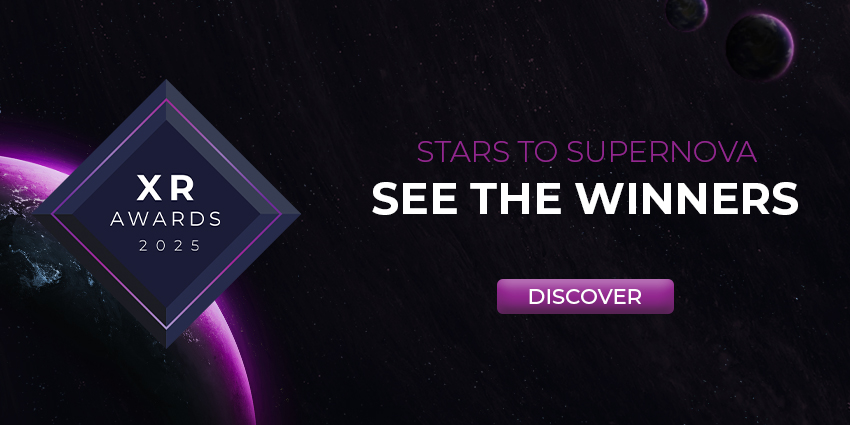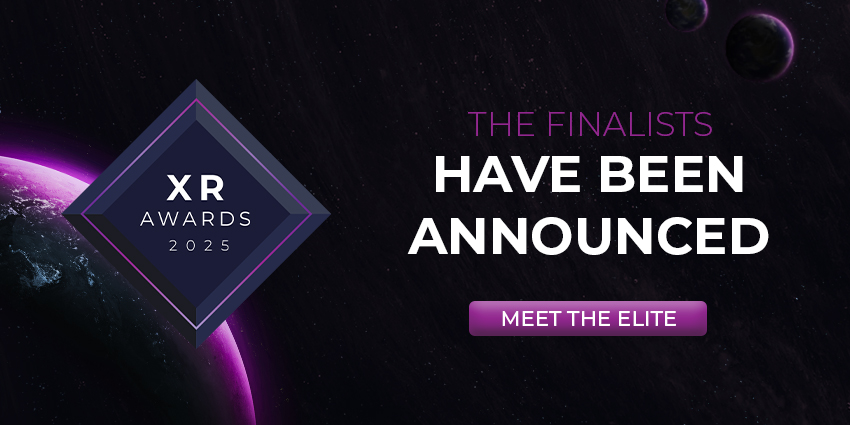The Immerse Global Summit (IGS) 2022 took place in Miami 5 to 7 December, and concluded its final days in the sunny backdrop of Miami Beach’s historic Fontainebleau Hotel.
Hosted by the Summit’s President and Founder Nathan Pettyjohn, Virtual and Augmented Reality Association’s (VRARA) Kris Kolo, and many others from the IGS and VRARA teams, the organisation’s latest iteration rallied some of the tech industry’s most prized companies, thought leaders, and experts.
The event also kicked off a series of stellar keynote speeches, workshops, product demos, and other feature presentations for the global tech industry. Many products showcased at the conference included flagship releases of VR headsets and solutions such as the Meta Quest Pro, Magic Leap 2, Lenovo ThinkReality A3, and AT&T’s Volumetric Video Photo Booth, among many others.
XR Today is honoured to summarise several featured stories from the meeting as part of our final event coverage of the global virtual, augmented, mixed, and extended reality (VR/AR/MR/XR) industry.
For our IGS summary, XR Today is pleased to welcome,
- Timothy Allen, Founder, Chief Executive, and President, Oberon Technologies
- Veronica Costa Orvalho, Founder, Chief Executive, Didimo
- Khalid al-Muawad, Chief Experience Officer, Midwam
- Casey Jensen, Vice President of US Sales and Marketing, rooom
- Tony Wang, Co-Founder and Chief Revenue Officer, Agora
- Marcin Klimek, Chief Executive, Exploded View
The six interviewees shared with XR Today their greatest takeaways from the global XR industry, challenges and hopes for the industry, and analysis of the future of the Metaverse.
Oberon Technologies
Allen discussed the benefits of immersive learning platforms, citing a company study on the return on investment (ROI) for clients via VR training. It revealed a fourfold increase in learner retention rates and long-term ones of up to 90 percent.
Regarding customer experiences (CX), Oberon also reported a 50 percent decrease in dissatisfied customers and 9.9 percent decrease in customer handling times, indicating both hard and soft ROIs.

He added his firm assessed industry averages and worked with customers to specify savings targets. According to his finds, energy industries such as nuclear power plants could save millions of dollars by expediting repair times, deploying technicians for less time, and avoiding accidents such as radiation exposure and other environmental risks.
Regarding upskilling challenges across multiple verticals, Allen discussed the costs and expenses of creating immersive learning experiences. Such tools needed a strong ROI to “compensate for those costs,” namely by reducing risks and creating on-demand training solutions.
Oberon’s virtualised training for power plants and other dangerous facilities “helped with the ROI for [their clients’] investments,” he stated, adding it was key to work with heavy industry companies “where the safety of communities, workers, the environment” was a “critical factor.”
Explaining further, he said,
“That’s been our focus: anything we can do to help customers reduce the amount of time in a critical incident or dangerous insert, or avoid hazards, is the kind of savings areas we’re exploring. It’s more soft savings, but in the end, it’s hard savings for everyone”
Allen added that instructors could conduct training modules remotely and learners no longer needed to visit secure facilities or in-person instruction with potentially dangerous or costly mistakes.
Digital twins used in the trainer provided one-eighth inch accuracy of facilities to familiarise learners with environments before travelling or working there. Delivering VR experiences and support for trainees, including service support, certification training, and operation instructions streamlined educational modules to fully prepare learners for their jobs.
The platform also supported legacy data for previous standard operation procedures (SOPs) and other VR content. This avoided fully redesigning content and combining old and new data.
rooom
Jensen first explained that rooom founder Hans Elsner originally created the solution as a 3D platform with advanced 3D compression technologies.
Later, the company moved towards the Metaverse, with the COVID-19 pandemic triggering rooom’s demand to develop immersive spaces complete with new 3D technologies.
rooom’s event platform “took off” due to its immersive capabilities to host products, 3D assets, and enterprises in virtual showrooms, leading to events, festivals, training modules, and other use cases.
When asked about the benefits of using rooom’s virtual spaces, Jensen stated the platform was “all about sustainability.”
Continuing, he explained,
“We’re working with a lot of companies to cut down travel and training costs. Currently, we have a big problem in the US and abroad with hiring and retraining, with constant turnover rates. many companies are automating their upskilling procedures, which is standard across many industries. We’re helping companies collaborate and train in virtual spaces to cut costs due to constant retraining”

He stated rooom also aimed to offer products across verticals, rather than salespeople showcasing devices at physical events.
The platform’s virtual labs provided a full range of device demos, including explosive views, product descriptions, and real-time product demos.
Following last year’s beta testing, rooom won several innovation contests with Deutsche Telekom. The new comprehensive system hosts full-scale events, virtual CX stores, product views, and other functions.
Explaining further, he said,
“We’ve done a lot of interesting demos with clients to learn how to make the more fluid, nut just for internal and business matter, but also for consumers. We wanted to bridge the gap between the real and virtual world while helping with customer service and product knowledge”
Additionally, the enterprise aims to “be a place where brands and different companies can get involved.” Such companies included those monitoring brands such as Nike and Gucci, who have adopted their own Metaverse strategies, and find metaverse adoption overwhelming.
Continuing, he said,
“Forbes called us the ‘WordPress of the Metaverse, and we want to make it a really democratised platform. We want to make it easier for people to test and adopt these solutions, understand metrics, experiment and take baby steps into it. We’re building the foundation right now for, down the road, when we have interoperability and a true Metaverse.
The Jena, Germany-based firm has also collaborated with the Khronos Group and Metaverse Standards Forum along with some of the world’s top tech firms.
Didimo
Didimo’s Orvalho started by discussing her company’s recent Series A fundraiser in early November, which she said was a “huge milestone” amid the ongoing global economic outlook.
The funding, worth $7.1 million USD, was proof the company had built technologies essential to the future of the Metaverse, she said. It would also use the funds to “put the product in the hands of [its] customers” by scaling technologies and building commercial teams.
When asked about its solutions, Orvalho explained that Didimo’s technologies take selfie photos of objects or people. Using AI-generated algorithms, she stated the platform automatically uploads 1,000s of photos to create digital avatars “even from people that don’t exist.”

Future interaction models would become a “digital extension” of users and offer a virtual identity for metaverse shopping, gaming, and try-on clothing.
Citing one of her favourite use cases, she predicted that in five years’ time people with disabilities could use the technology to reconstruct faces or bodies while interacting in the Metaverse. Additional use cases included educational purposes, where avatars could interact with real-time language translations.
Orvalho added such efforts would lead to “building the next interaction model to support new ways of communicating.”
Explaining further, she said that people typically idealised their online personalities by applying photo filters, adding,
“We choose which represents us the best because we can customise, personalise, add makeup and tattoos to, change garments, and other adjustments. We provide the fundamental elements, and then users can personalise them for different environments, whether for work or leisure.
When asked why enterprises were leveraging avatar technologies, the executive said it was “very industry-dependent.” Some used avatars for fashion try-ons to reduce the cost of returns and avoid overproduction by allowing companies to scale production to order.
In gaming or social metaverses, people could also use avatars to reduce costs related to creating digital characters. Artists previously used very expensive hardware and software to create digital assets, namely with delayed throughput. Didimo’s technologies eliminated this by producing avatars “at scale.”
She added: “What we have built is a single destination for creating digital characters across verticals.”
She explained two main processes when asked whether avatars would incorporate future technologies such as blockchain, cryptocurrencies, and other digital assets.
From a top-down perspective, technology firms needed to create “complex” systems for digital assets with “the geometry, rig, animation, shaders,” and other tools.
She said,
“It’s really complex and you need to provide it to companies creating the games and [platforms] for metaverse experiences and integrate the technologies for compatibility. We use open standards and are completely interoperable”
Regarding consumer adoption, she said that interoperable platforms could embed digital characters on multiple environments and metaverses, leading to the integration of blockchain technologies, increased identity protections, and other security measures.
According to Orvalho, people only needed to provide selfies or descriptors for creating digital characters with AI-backed voice commands, allowing users to secure and own their identities. Users could also choose where their avatars would interact with digital assets in different environments.
Midwam
According to AlMuawad, Midwam’s solutions were key to developing Saudi Arabia as a strategic tech and metaverse incubator. He explained in his interview that the Middle Eastern country was playing a major role in incubating emerging technologies and firms dedicated to the industry.

The company, founded in 2012, believed that Middle Eastern projects and the global market strengthened the industry with numerous experiences and knowledge for developing projects.
Midwam currently has a 30-person-strong team from multiple backgrounds with over 20 years of combined experience. It develops immersive experiences based on knowledge across verticals such as entertainment, tourism, culture, sports, and others.
Speaking on Midwam’s industry and global partnerships, he explained that real-time 3D (RT3D) platforms such as Unity Technologies and Epic Games’ Unreal Engine had collaborated “for many years” and were “reliable companies.”
He continued, stating,
“We like to work with a lot of partners because we are a local company with local knowledge. We deal with local sectors and each of them require subject matter experts for consulting projects. We have technology partners depending on the type of development for each project and exchange programmes for knowledge transfers”
AlMuawad added that Midwam worked with firms like Unity for training programmes that “uplifted the capabilities [of] developers in Saudi,” along with tech hubs in Dubai, the United States, and others.
Concluding on the direction of the Metaverse, he stated that it was an exciting space to have and a “reality check” on people’s transactions, behaviour, communications, and connections.
Developing the industry would take more time for people to “understand the real dynamic of that space,” he said.
He continued that younger generations would offer added value with enthusiasm, but would need “a little bit more time for people to adopt and understand what’s possible in that space.”
He concluded that companies such as Midwam could help create interesting developments to educate people in the space and boost their interactions.
ExplodedView
Similarly to Didimi, ExplodedView’s Klimeck explained the importance of avatar firms, stating that, for the first time, people could have “actual representations” of themselves to navigate the Metaverse.
Platforms like Ready Player Me were developing interoperable, bespoke platforms for avatars, creating a new economy around the concept.
Speaking further, he said,
“All the experts at [the IGS] agreed that avatars would become a ‘thing.’ They were all using them, including myself, and my avatar is an expansion of my personality [in the Metaverse]. Imagine a future where every single person uses an avatar [to interact]”
Avatar technologies received more funding to create a new economy for enterprises. This created new business models to reach people “in a completely new way.”
He explained that younger audiences had become accustomed to “living with their avatars since their infancy” and building them from the beginning, from three to four years old.
Continuing, he said,
“For brands to expand and explore opportunities across younger demographics, [they must understand that this] will generate much of the revenue in the very near future”

He segued to his firm’s Web3 technologies, including face, hand, and eye-tracking, stating research conducted roughly two years ago had built and developed frameworks for Google’s ARCore and Apple’s iOS ARKit. Such platforms provided live data for face tracking, including facial expressions, eye movement, and other features. Currently, ExplodedView is iOS exclusive.
The company focused on developing its quality of content and expressions due to positive feedback to create added realism.
ExplodedView also aimed to build emerging technologies such as AI and machine learning (ML) but needed to determine the best applications for such tools. Currently, face tracking for platforms like MediaPipe did not function interoperably, presenting new challenges for developers.
Explaining further, he said,
“Most don’t consider that [one of the world’s main platforms] only gives you six frames per second, and is sometimes unusable. Face tracking and camera resolutions need to improve. Meta’s face tracking is a game-changer for communication [which was] a completely different level of communication.”
Companies developing solutions similar to HTC VIVE’s lip-tracking tools would deepen immersion and lead to greater levels of realism for avatar development.
Concluding, Klimeck discussed the potential of deeper emerging technology integration for avatars in the Metaverse, by solving similar current and future problems. He said he was also fortunate to see “the development of mobile devices from the very beginning” as an example of previous challenges.
Conversely, ethics were an important concern for developers to avoid discrimination based on physical appearances, similar to passport travel and others forms of transport.
Explaining, Klimeck said in the interview,
“The Avatar itself will be treated as part of a user’s identity. Systems will not validate the avatar itself, but the blockchain-based records behind them. In reality,m you get your passport assigned in the future, but what happens when you have different avatars? A person can fake a passport, but cannot have multiple versions using different passports. If a person has up to 20 or more avatars with each doing something, and one committing a crime, do you ban one or all of the avatars?”
He concluded that many people were not concerned enough about privacy. As avatars received more functionality in the Metaverse, people would value them more as an extension of themselves.
The trigger would come as people increasingly valued these identities, avatars, and creative content as further discussions took place in future events.
Agora
Speaking to XR Today for the first time since his keynote speech at the Real-Time Engagement (RTE) 2022, Wang stated the event was “a very successful one” and that future ones would remain “globally distributed, decentralised, and immersive.”
Agora would also also advance its full-release solution stack, covering technologies such as spatial, high definition (HD), and ambisonic audio formats, as well as video latency for broadcasting, voice-powered apps, and others. The company also planned a full-stack solution for app developers “as the content creator for the web age.”
He added: “We believe that if you have five, ten, or even 1,000 apps, the industry will begin to take off and everybody will benefit downstream at the hardware level.”
Agora also has numerous companies exploring the Metaverse with new technologies, which aimed to empower content creators, metaverse platforms, and democratise Web3 solutions.
He also stated the Metaverse needed to supercede national boundaries, political events, and other differences. Wang added,
“We have the chance in the virtual world to form a new community — one that is purely organised in a distributed global fashion, based on passions and common interests. Despite national boundaries, people will gather in communities, sometimes from 50 different countries. Cryptocurrencies and decentralised finance (DeFi) would provide the base to sustain such communities, without fiat currencies in the distant future”
Secondly, he added that nations were moving away from globalisation 1.1, which had “bugs” similar to many technologies. Nations were also retreating back to older, protected systems, he said.

Despite this, the online world would merge in an “unprecedented way,” and Agora would provide software developer kits (SDKs) to build the Metaverse as a “dream weaver of the future world.” Developers would use their passion and visions to build solutions to break communication barriers.
Live translation software would also facilitate such measures, allowing unprecedented interactions. This would also lead to new monetisation models outside YouTube or Facebook advertisements.
Regarding the potential of the Metaverse to empower content creators with new devices and hardware maturity, he said that changing user behaviours and hardware was difficult.
Wang congratulated companies attending the event for their efforts to develop hardware via research and development (R&D), prototyping, and mass production, which was “pushing this industry forward.”
He also called for the industry to build standards for greater interoperability. Citing Elon Musk’s patenting and developing auto-drive technologies, he said the tech magnate “advanced the entire industry with one base standard.”
These breakthroughs would “quickly promote consumer adoption,” which he urged the industry to address and expedite adaptation. Concluding, he said: “We all believe we have the conviction that this will happen. The challenge is when and how.”







